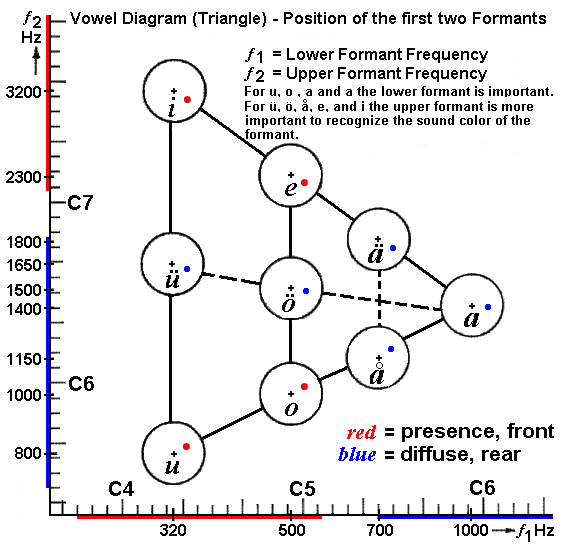

| Deutsche Version |
 |
| The spectral peaks of the sound spectrum are called formants. A formant refers to a peak in the spectrum. The frequency of the first formant is mostly determined by the height of the tongue body: ● high f1 = low vowel (i.e., high frequency f1 = low tongue body) ● low f1 = high vowel (i.e., low frequency f1 = high tongue body) The frequency of the second formant is mostly determined by the frontness/backness of the tongue body: ● high f2 = front vowel ● low f2 = back vowel Blauert's front band: present, in front = red Blauert's rear band: diffuse, in rear = blue |
Vowel formants
| Vowel | Main formant region |
| u | 200 to 400 Hz |
| o | 400 to 600 Hz |
| a | 800 to 1200 Hz |
| e | 400 to 600 and 2200 to 2600 Hz |
| i | 200 to 400 and 3000 to 3500 Hz |
Vowel formant centers
| IPA | German Vowel | Formant f1 | Formant f2 |
| u | U | 320 Hz | 800 Hz |
| o | O | 500 Hz | 1000 Hz |
| ɑ | å | 700 Hz | 1150 Hz |
| a | A | 1000 Hz | 1400 Hz |
| ø | ö | 500 Hz | 1500 Hz |
| y | ü | 320 Hz | 1650 Hz |
| ɛ | ä | 700 Hz | 1800 Hz |
| e | E | 500 Hz | 2300 Hz |
| i | I | 320 Hz | 3200 Hz |
Typical spectral lifting - Bandwidth fifth to octave
| Strong amplitude at | Sensation of sound | Comment |
| 200 to 400 Hz | sonorous | 1st formant u |
| 400 to 600 Hz | full | 1st formant o |
| 800 to 1200 Hz | striking | 1st formant a |
| 1200 to 1800 Hz | nasal | 2nd formant ü |
| 1800 to 2600 Hz | bright | 2nd formant e |
| 2600 to 4000 Hz | brilliant | 2nd formant i |
| 8000 Hz | peakish | diffuse "highs" |
| over 10000 Hz | sharp | overtone "gloss" |
Formant Range of Woodwind Instruments *)
| *) From: Paul Heinrich Mertens, "Die Schumannschen Klangfarbengesetze und ihre Bedeutung für die Übertragung von Sprache und Musik", Verlag "Das Musikinstrument" Erwin Bochinsky, Frankfurt/M, 1975. ISBN 3-920-11254-7 |
| Musical Instrument |
Main range about |
Adjacent range about |
| Flute | 810 Hz | - - - - |
| Oboe | 1400 Hz | 2950 Hz |
| English horn | 950 Hz | 1350 Hz |
| Clarinet | 1180 Hz | 2700 Hz |
| Bassoon | 440 Hz | 1180 Hz |
| Contra bassoon | 250 Hz | 450 Hz |
Double reed instruments have particularly strong formants
Formant Range of Brass Instruments
| Musical Instrument |
Main range about |
Adjacent range about |
| Horn | 340 Hz | 750 Hz |
| Trumpet | 1200 Hz | 2200Hz |
| Trombone | 520 Hz | 1500 Hz |
| Bass trombone | 370 Hz | 720 Hz |
| Tuba | 230 Hz | 400 Hz |
The formation of the formants on brass instruments is caused by the mouthpiece.
Formant Range of String Instruments
| Musical Instrument |
Main range about |
Adjacent range about |
| Violin | 400 Hz | 1000 Hz |
| Viola | 220/350 Hz | 600/1600 Hz |
| Violoncello | 250/400 Hz | 600/900 Hz |
| Double bass | 70 Hz | 250 Hz |
| The sound spectra of string instruments are very individual due to large structural differences. The range of the formants are highlighted by resonances of the resonator and the entrapped air from the spectrum of the vibrating strings. |
Directional Bands after Jens Blauert (Blauert's Bands)
| Perception | Main range about |
Adjacent range about |
| present, front (red) | 3150 Hz | 315 Hz |
| diffuse, rear (blue) | 1000 Hz | (10 000 Hz) |
| Jens Blauert, "A novel Presence Filter" (German): http://www.sengpielaudio.com/Blauert-Filter.pdf Frequency Positions of the Vowel Formants and "Blauert's Bands" (German): http://www.sengpielaudio.com/FrequenzDerFormanten.pdf "Localization not only in the median plane (German)": http://www.sengpielaudio.com/DieRichtungswahrnehmungMedianebene.pdf "German Vowels": http://learn-german.language101.com/how-to/german-vowels/ |
| back |
Search Engine |
home |